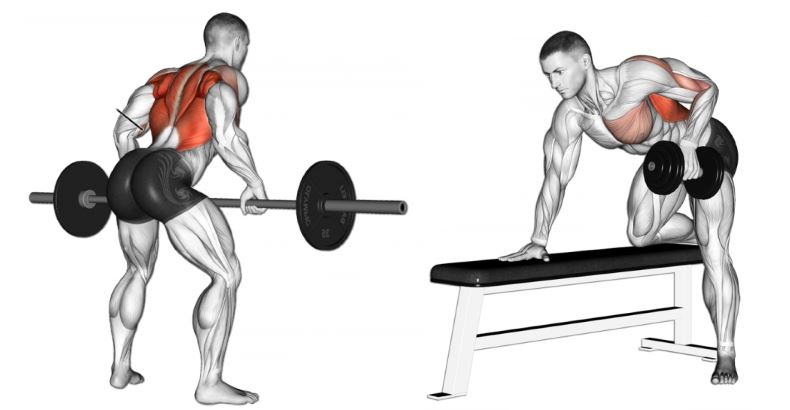The bent-over row is a classic move that builds upper back thickness and lower back strength and endurance, while also improving shoulder stability by counterbalancing what the bench press does to your shoulders. It primarily targets the lats and rhomboids, but works the biceps, traps, delts and core muscles to some extent as well. When barbell and dumbbell bent over rows are performed with proper form, they have strong direct transference to the bench press, squat and deadlift.
Unfortunately, the bent-over row is also an exercise many lifters get wrong due to its seemingly confusing technical aspect, which increases their risk of devastating back injuries, including spinal disc herniation. This article will help you execute both the barbell and dumbbell row with proper form and get the most out of these great old-school back-builders.
#1. One Arm Dumbbell Row – Benefits and proper form
Although the barbell variation offers superior muscle building benefits, the dumbbell variation has some very strong benefits as well. In fact we did some analysis and came to the conclusion that the dumbbell row might be superior to the barbell row. Here is the whole article. Among other things, it allows you to isolate one side of the lats at a time and correct any strength imbalances in this muscle area, which will undoubtedly lead to an improved performance on all your major lifts.
How to perform one-arm dumbbell bent-over rows with proper form:
There are a couple of different variations of the one-arm dumbbell row, but this is the most common variant used and will safely allow for heavier weights:
Standing one arm dumbbell row proper execution

- Stand next to a bench or a dumbbell rack with the knees the feet at shoulder-width apart and slightly bent. Hold a dumbbell in front of you with a neutral grip.
- Lean on the bench/dumbbell rack with the other hand for support.
- From this position, row the dumbbell toward the waist until you feel a good contraction in the lats and mid-back muscles. Lower it back down until the arm gets fully extended toward the floor. Do 10-12 reps and repeat the exercise with the other arm.
Knee on bench one arm dumbbell row proper execution
There is also a second variant of the one-arm dumbbell row, With one knee and one arm leaning on the bench. This exercise doesn’t allow for big weights like the standing variant though.

- Stand next a bench or dumbbell rack with the knees bent slightly and the feet apart as your shoulder width. Pick up a dumbbell with a neutral grip.
- Lean on the the bench/dumbbell rack with the other hand for support.
- From this position, row the dumbbell toward the waist until you feel a good contraction in the lats and mid-back muscles. Lower it back down until the arm is fully extended toward the floor. Do this move for 10-12 reps and then repeat with your other arm.
- Take a pair of dumbbells and find a flat bench.
- Place the left leg, bent at the knee, on top of the bench, and place your left hand at the front of the bench. The right leg should be planted firmly on the ground.
- Raise your chest to ensure your back is parallel to the floor.
- Grab a dumbbell with your right hand, palm facing towards your body.
- Check if your lower back is straight and correct it if needed. Keep it neutral all throughout the movement.
- As you exhale, pull through the elbow until the dumbbell reaches the side of your chest, right underneath your right armpit.
- At the top of the contraction pause for a second and give your lats a hard squeeze.
- As you inhale, slowly lower the weight to the starting position, focusing on the stretch.
- Keep your form strict and tight at all times.
- Perform 4 sets of 12-15 reps with each arm.
#2. Bent Over Barbell Row Proper Form
The bent over barbell rows should be a staple in your back routine. Using a barbell enables you to handle more weight and target the middle area of your back more efficiently, as long as you perform it with perfect form.
Avoid slouching your back at all costs as this can lead to back injury. With this variation you can use a pronated (palms facing down) or supinated (palms facing up) grip – the first one will provide a wider angle and place a stronger emphasis on your lats and rhombs, while the second will provide a greater bicep engagement and allow you to handle more weight. Make sure to include both grips in your routine for optimal results.
Here’s how to perform bent over barbell rows:

bent over barbell row
- While holding a barbell with a pronated or supinated grip, slightly bend your knees and bring your torso forward by bending at the waist but keep the back straight until it’s almost parallel to the floor.
- As you exhale, pull through the elbows until the bar reaches your midsection. The torso should remain stationary.
- At the top of the contraction, pause for a second and squeeze your lats and rhombs.
- As you inhale, slowly bring the weight down, focusing on the stretch.
- Perform 4 sets of 8-12 reps.
Using the barbell and dumbbell bent over row with proper form will help you work your lats, rhombs, rear delts, traps and even biceps in the most effective way. Adding them to your regular back routine is a surefire way to get the most of your back training!
